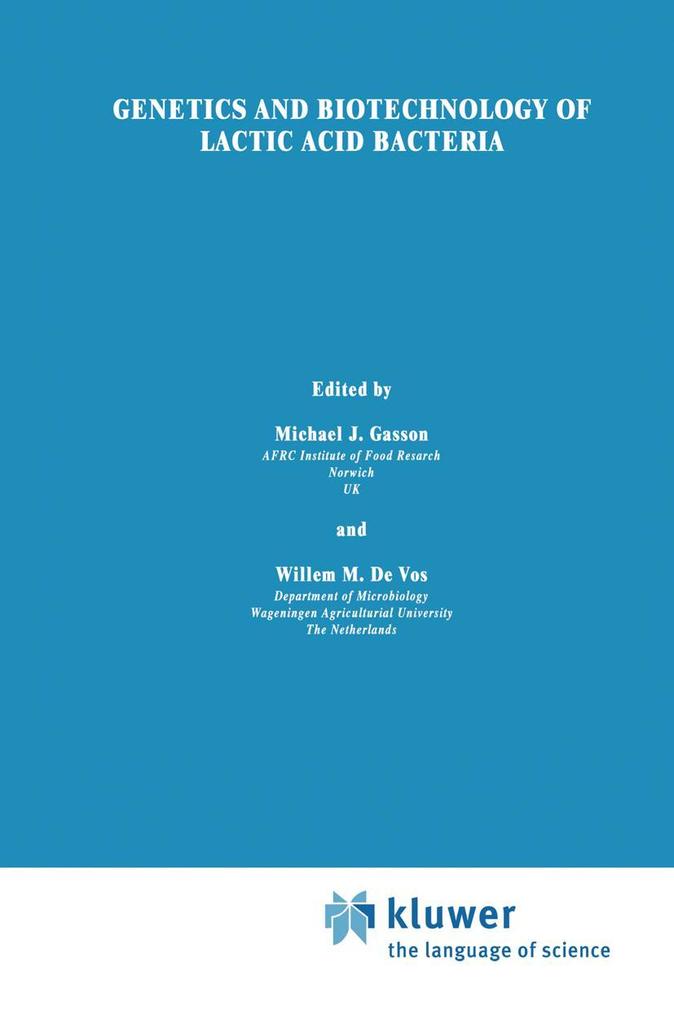
Zustellung: Fr, 18.07. - Di, 22.07.
Versand in 7 Tagen
VersandkostenfreiBestellen & in Filiale abholen:
A prime reference volume for geneticists, food technologists and biotechnologists in the academic and industrial sectors. Fermentations with lactic acid bacteria determine important qualities such as taste, shelf-life, and food values. New methods of food production require fast and reliable manufacture, which has led to a dramatic surge of interest in the genetic, microbiological and biochemical properties of lactic acid bacteria.
Inhaltsverzeichnis
1 Gene transfer systems and transposition. - 1. 1 Introduction. - 1. 2 Conjugation. - 1. 3 Transduction. - 1. 4 Transformation. - 1. 5 Protoplast fusion. - 1. 6 Transposition. - 1. 7 Generalized recombination. - 1. 8 Chromosome mapping. - 1. 9 Concluding remarks. - References. - 2 Gene cloning and expression systems in Lactococci. - 2. 1 Introduction. - 2. 2 Replicative gene cloning. - 2. 3 Integrative gene cloning. - 2. 4 Gene expression signals. - 2. 5 Control of gene expression. - 2. 6 Protein secretion. - 2. 7 Expression and secretion systems. - 2. 8 Food grade systems. - References. - 3 Bacteriophages and bacteriophage resistance. - 3. 1 Introduction. - 3. 2 Types and species of bacteriophages. - 3. 3 Gene directed bacteriophage resistance in lactic acid bacteria. - 3. 4 Novel phage defense mechanisms. - 3. 5 Genetic strategies to construct phage-insensitive strains. - 3. 6 Conclusions and perspectives. - References. - 4 The proteolytic system of lactic acid bacteria. - 4. 1 Introduction. - 4. 2 Proteinases. - 4. 3 Endopeptidases. - 4. 4 General aminopeptidases. - 4. 5 Proline-specific peptidases. - 4. 6 Oligo-and carboxypeptidases. - 4. 6. 1Dipeptidases. - 4. 7 Transport of amino acid and peptides. - 4. 8 Cellular localization of proteolytic enzymes. - 4. 9 Engineering of the proteolytic system. - References. - 5 Bacteriocins of lactic acid bacteria. - 5. 1 Introduction. - 5. 2 Small heat-stable bacteriocins. - 5. 3 Large heat-labile bacteriocins. - 5. 4 Lantibiotics in lactic acid bacteria. - 5. 5 Concluding remarks. - References. - 6 Genetic engineering of lactobacilli, leuconostocs and Streptococcus thermophilus. - 6. 1 Introduction. - 6. 2 Overview of taxonomy and health benefits. - 6. 3 Biochemical traits. - 6. 4 Plasmid biology and cloning vectors. - 6. 5 Genetic transfer methods. - 6. 6 Gene expression in lactobacilli. - 6. 7 Gene expression in S. thermophilus and leuconostocs. - 6. 8 Chromosomal integration of genes. - 6. 9 Phage and phage resistance. - 6. 10 Concluding remarks. - Dedication and acknowledgements. - References.
Produktdetails
Erscheinungsdatum
31. Dezember 1993
Sprache
englisch
Auflage
1994
Seitenanzahl
316
Herausgegeben von
Michael J. Gasson, W. de Vos
Verlag/Hersteller
Produktart
gebunden
Abbildungen
XI, 300 p.
Gewicht
641 g
Größe (L/B/H)
241/160/22 mm
ISBN
9780751400984
Entdecken Sie mehr
Pressestimmen
The contributions take an academic approach in that they emphasise the basic research underlying potential applications themselves. The comprehensive cover of these areas should prove invaluable to workers in the field. This volume will also provide an excellent introduction to these bacteria for geneticists more familiar with other species. - Journal of Chemical Technology and Biotechnology; . . . will supply a rich source of information for researchers new to the field as well as providing a broad reference base for specialists. . . may prove inspirational for new research - Society for General Microbiology Quarterly; This book will be indispensable to anyone embarking on a career in research in the area of molecular biology of lactic acid bacteria and will certaintly have something to offer current researchers. - The Genetic Engineer and Biotechnologist
Bewertungen
0 Bewertungen
Es wurden noch keine Bewertungen abgegeben. Schreiben Sie die erste Bewertung zu "Genetics and Biotechnology of Lactic Acid Bacteria" und helfen Sie damit anderen bei der Kaufentscheidung.










